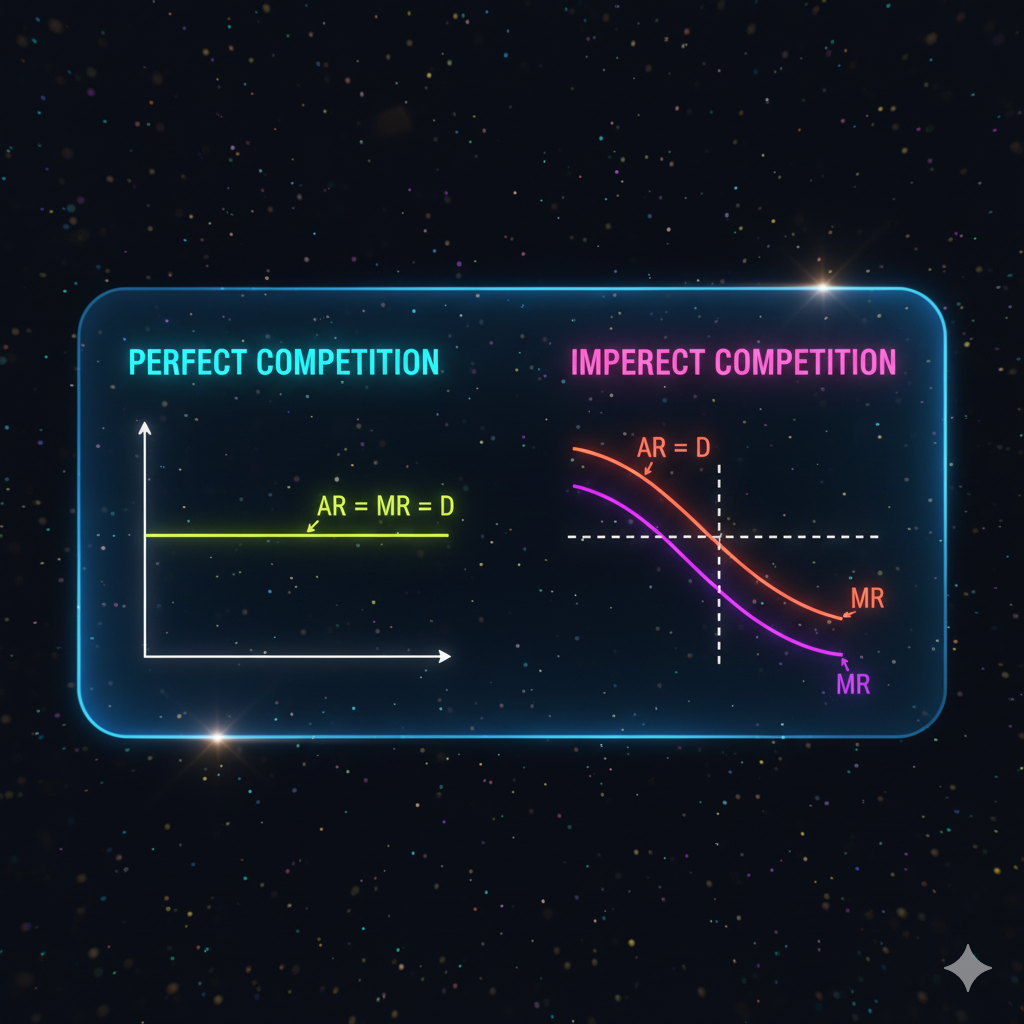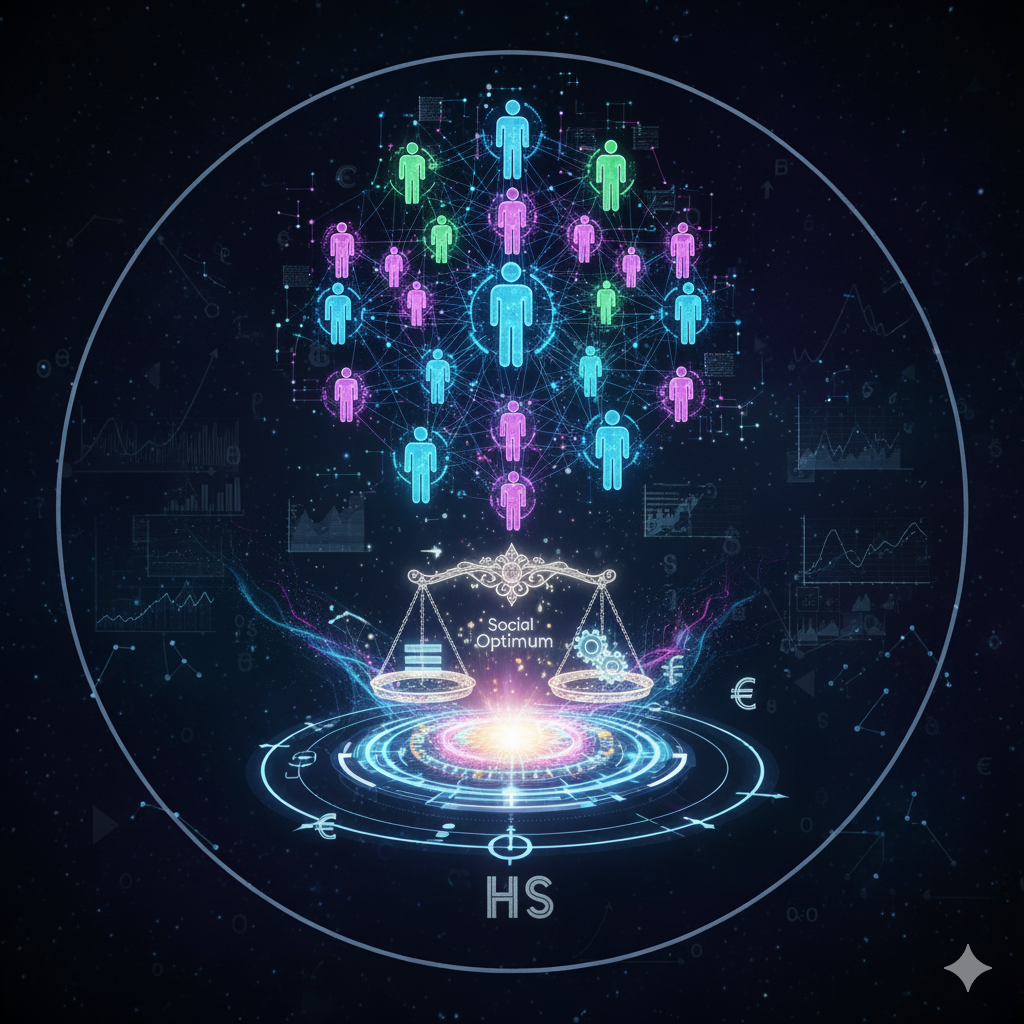Introduction
In the study of microeconomics, the concepts of Average Revenue (AR) and Marginal Revenue (MR) hold significant importance for analyzing the revenue behavior of a firm. These concepts help in understanding how much revenue a firm earns per unit of output and how revenue changes when output increases by one unit.
The relationship between AR and MR curves is crucial because it reflects the market structure under which a firm operates. In perfect competition, the relationship between AR and MR is different from that in imperfect competition (which includes monopoly, monopolistic competition, and oligopoly).
This article provides a comprehensive explanation of AR and MR, their mathematical and graphical relationships, and a detailed analysis of their reciprocal relation in both perfect and imperfect competition.
Understanding Average Revenue (AR) and Marginal Revenue (MR)
1. Average Revenue (AR)
Definition:
Average revenue is the revenue earned per unit of output sold. It is obtained by dividing the total revenue (TR) by the number of units sold (Q).
Formula: AR=TRQAR = \frac{TR}{Q}AR=QTR
Since Total Revenue = Price × Quantity, we can also say: AR=P×QQ=PAR = \frac{P \times Q}{Q} = PAR=QP×Q=P
Thus, in economics, AR is equivalent to Price of the commodity.
2. Marginal Revenue (MR)
Definition:
Marginal revenue is the additional revenue earned by selling one more unit of output. It shows the rate of change of total revenue with respect to output.
Formula: MR=ΔTRΔQMR = \frac{\Delta TR}{\Delta Q}MR=ΔQΔTR
In calculus form: MR=d(TR)dQMR = \frac{d(TR)}{dQ}MR=dQd(TR)
3. Relation Between AR and MR
- AR represents the revenue per unit, while MR represents the change in revenue from selling an extra unit.
- In perfect competition, AR = MR = Price.
- In imperfect competition, MR < AR because to sell additional units, the firm must lower the price.
Reciprocal Relation of AR and MR: Conceptual Basis
The reciprocal relation refers to the mathematical and graphical relationship between AR and MR curves. This relation depends on the elasticity of demand and the type of market structure.
The general relation can be expressed as: MR=AR(e−1e)MR = AR \left( \frac{e – 1}{e} \right)MR=AR(ee−1)
Where:
- eee = Price elasticity of demand
- If e=∞e = \inftye=∞ (perfectly elastic demand, as in perfect competition), then MR = AR.
- If e>1e > 1e>1, MR is positive but less than AR.
- If e=1e = 1e=1, MR = 0.
- If e<1e < 1e<1, MR is negative.
Thus, the reciprocal relation of AR and MR curves depends on elasticity of demand and varies across different market structures.
AR and MR in Perfect Competition
Features of Perfect Competition
- A large number of buyers and sellers.
- Homogeneous product.
- Perfect knowledge of the market.
- Free entry and exit of firms.
- Firm is a price-taker, not a price-maker.
Behavior of AR and MR
In perfect competition:
- Price remains constant regardless of the output level.
- Total revenue increases proportionally with output.
- Hence, AR = MR = Price at all levels of output.
Graphical Representation
- The AR curve is a horizontal straight line parallel to the X-axis, indicating a constant price.
- The MR curve coincides with the AR curve.
Explanation:
Suppose price = ₹10. If the firm sells 1 unit, TR = 10. If it sells 2 units, TR = 20, and so on. Thus:
- AR = 10 always.
- MR = 10 always.
Therefore, in perfect competition, AR and MR are equal, and both curves are horizontal at the given market price.
Reciprocal Relation
- Elasticity of demand = ∞ (perfectly elastic).
- According to formula:
MR=AR×∞−1∞=ARMR = AR \times \frac{\infty – 1}{\infty} = ARMR=AR×∞∞−1=AR
- Hence, in perfect competition, AR = MR.
AR and MR in Imperfect Competition
Features of Imperfect Competition
- Single seller (monopoly) or few sellers (oligopoly) or differentiated products (monopolistic competition).
- Firm is a price-maker, not price-taker.
- To increase sales, the firm must reduce price.
Behavior of AR and MR
- The AR curve slopes downward from left to right (demand curve).
- The MR curve also slopes downward but lies below the AR curve.
- The gap between AR and MR increases as output increases.
Graphical Representation
- If the firm sells at a lower price to sell more, the additional revenue gained from each extra unit (MR) is less than the average revenue (AR).
- Thus, MR is always below AR in imperfect competition.
Example
Suppose a firm faces the following demand schedule:
| Quantity (Q) | Price (P = AR) | TR = P×Q | MR (ΔTR/ΔQ) |
|---|---|---|---|
| 1 | 10 | 10 | 10 |
| 2 | 9 | 18 | 8 |
| 3 | 8 | 24 | 6 |
| 4 | 7 | 28 | 4 |
| 5 | 6 | 30 | 2 |
| 6 | 5 | 30 | 0 |
| 7 | 4 | 28 | -2 |
- AR (price) declines as quantity increases.
- MR declines faster and becomes negative after a certain point.
Reciprocal Relation
Using the elasticity formula: MR=AR(e−1e)MR = AR \left( \frac{e – 1}{e} \right)MR=AR(ee−1)
- When demand is elastic (e > 1), MR is positive but less than AR.
- When demand is unit elastic (e = 1), MR = 0.
- When demand is inelastic (e < 1), MR is negative.
Thus, in imperfect competition, MR lies below AR and diverges as output expands.
Key Differences: Perfect vs. Imperfect Competition
| Aspect | Perfect Competition | Imperfect Competition |
|---|---|---|
| AR Curve | Horizontal, parallel to X-axis | Downward sloping demand curve |
| MR Curve | Coincides with AR | Lies below AR |
| AR and MR Relation | AR = MR = Price | MR < AR |
| Elasticity of Demand | Perfectly elastic (∞) | Greater than 1, falls with output |
| Gap Between AR and MR | No gap | MR diverges below AR |
| Revenue Behavior | TR increases proportionately | TR increases at diminishing rate, then may fall |
Importance of Studying AR and MR Relations
- Pricing Decisions: Firms can decide the level of output and price by understanding AR and MR curves.
- Profit Maximization: The equilibrium condition MR=MCMR = MCMR=MC is crucial for determining the firm’s output in both perfect and imperfect competition.
- Market Analysis: Helps in distinguishing between different market structures.
- Policy Implications: Government can design taxation and competition policies by analyzing revenue relations.
Critical Evaluation
- The reciprocal relation of AR and MR is straightforward in perfect competition but more complex in imperfect competition due to declining demand elasticity.
- In practical markets, firms rarely face perfect competition; hence, the imperfect competition model is more realistic.
- The AR-MR framework also forms the foundation of advanced topics such as monopoly pricing, price discrimination, and monopolistic competition analysis.
Conclusion
The relationship between Average Revenue (AR) and Marginal Revenue (MR) is fundamental in economics to understand firm behavior under different market structures.
- In perfect competition, AR and MR are equal, constant, and coincide with the market price. The reciprocal relation is simple because demand is perfectly elastic.
- In imperfect competition, AR slopes downward, and MR lies below it, with the gap widening as output increases. The reciprocal relation is explained by elasticity of demand:
- When elasticity > 1, MR is positive but less than AR.
- When elasticity = 1, MR is zero.
- When elasticity < 1, MR is negative.
Thus, while perfect competition shows a straightforward reciprocal relation (AR = MR), imperfect competition demonstrates a more nuanced and realistic relationship where MR always falls below AR.




